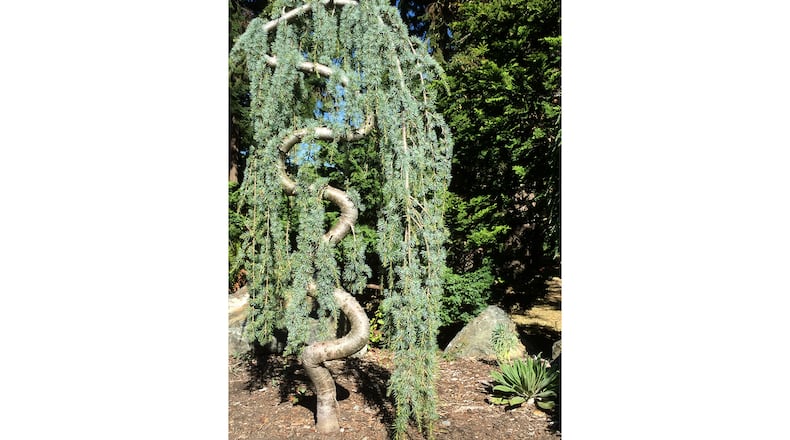Q: On the Georgia Tech campus, I saw a weeping tree growing in a zigzag form, not straight up like most trees. Why does it grow like this? Andrew Rissler, Atlanta
A: I’ll bet you saw a weeping Atlas cedar, Cedrus atlantica ‘Glauca Pendula.’ It does that (weep) because a change in the growing tip caused growth to go horizontal rather than vertical. This plant initially grows vertically, but after several years, it begins to lose its verticality and grow horizontally. It can be trained over several years to produce the serpentine shape you noticed.
Q: I have an infestation of centipede in my Meyers zoysia lawn. During the dormant season, it readily shows up as much darker than the dormant zoysia. Is it OK to spray the dormant centipede with Roundup without harming the dormant zoysia? Jim McVea, Forsyth County
A: I doubt you have centipede grass. In the winter, zoysia is completely brown and centipede a very light greenish yellow. I’ll bet you have carpetgrass, which looks very much like centipede in the summer. That’s bad news because carpetgrass is very hard to control with older chemicals. It’s a good thing herbicide research is ongoing. I haven’t used it but the label for Celsius WG indicates that it will control broadleaf carpetgrass, Axonopus compressus, and is safe to use on zoysia. Do your own research; read and follow the label exactly. This herbicide is comparatively expensive, but you can save money by using the single-use packages. Note that it only covers 2,000 square feet at the rate you’ll use. While you’re shopping, get some non-ionic surfactant. When mixed with herbicide, it helps the chemical(s) be absorbed by the weed leaves. Changing the environment of your lawn can be of use too. Keep your lawn on the dry side, fertilize appropriately for zoysia grass, and raise the pH based on a soil test, georgiasoiltest.com.
Q: On my trip to Japan, I bought some black Japanese bowls and small jewelry chests. When I got home, people told me the lacquer on my urushi ware was made from poison ivy and would make me itch. Is that true? Grey East, Albuquerque, N.M.
A: It is true that urushiol, the irritant that most of us fear, is found in poison ivy vine, Toxicodendron radicans, and the sap of the urushi tree, Toxicodendron vernicifluum. The tree is native to China, Korea, Japan and the eastern Himalayas. Urushiol is collected from the trees and is painted onto wooden objects to protect them. When urushiol is exposed to moisture and air, it polymerizes and becomes a very hard, durable, non-irritating plastic-like substance similar to black lacquer.
Email Walter at georgiagardener@yahoo.com. Listen to his occasional garden comments on “Green and Growing with Ashley Frasca” Saturday mornings on 95.5 WSB. Visit his website, walterreeves.com, or join his Facebook page at bit.ly/georgiagardener for his latest tips.
About the Author
The Latest
Featured

